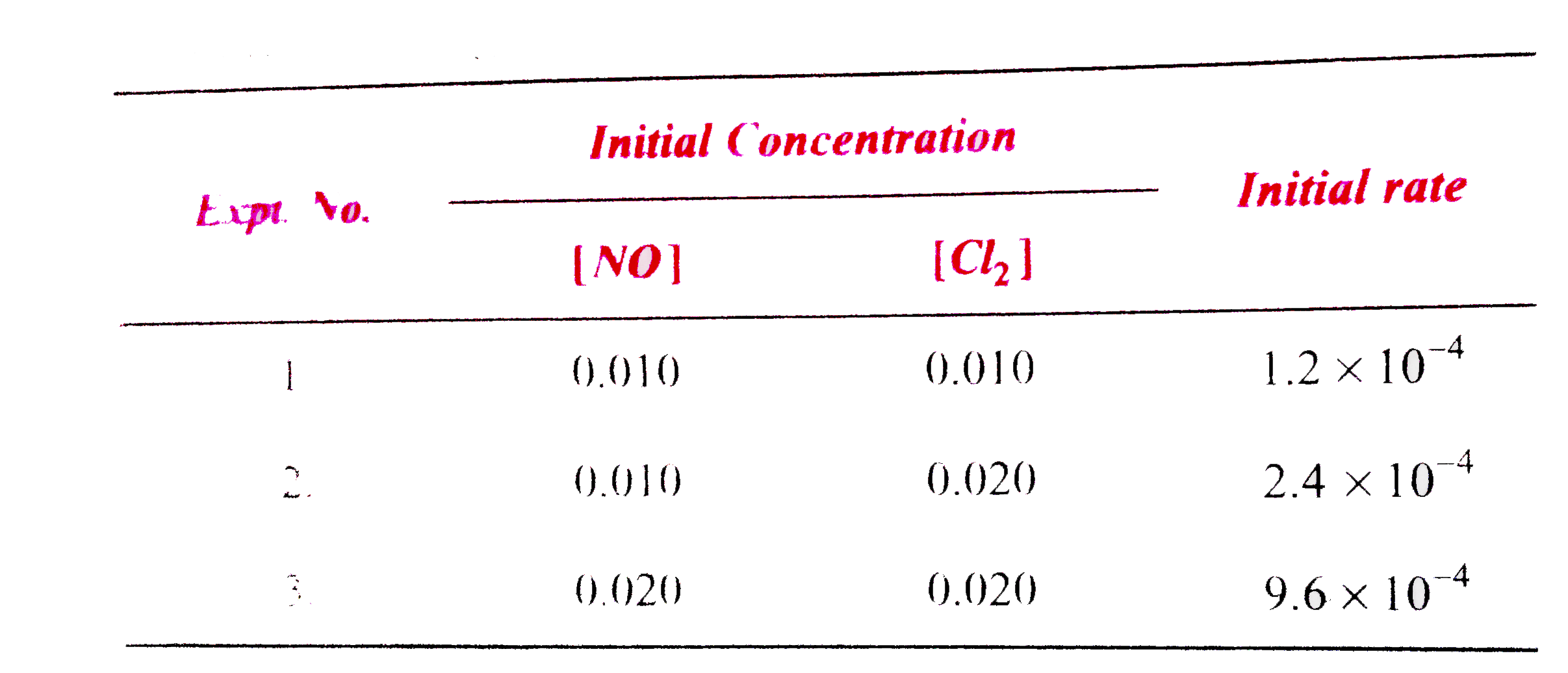The following rate data were obtained at 303K for the following reaction:
2A+B→C+D

What is the rate law? What is the order with respect to each reactant and the overall order? Also calculate the rate constant and wriye its units.
form experiment I and IV, it may be noted that [B] is same but [A] has been four times. The rate of reaction also has become four times. This means that order w.r.t. A,
Rate ∝[A] …(i)
form experiment II and III, it may be noted that [A] is kept same and [B] has been doubled, the rate of reaction has become four times. This means that order w.r.t. B,
Rate ∝[B]2 ...(ii)
Combining (i) and (ii), we get the rate law for the given reaction as:
Rate =k[A][B]2
Thus, order w.r.t. A=1, order w.r.t. B=2, and overall order of the reaction =+2=3.
The rate constant and its units can be calculated form the data of each experiment uisng the expresison
k=Rate[A][B]2=molL−1−1min(molL−1)(molL−1)2=mol−2L2−1min

∴ Rate constant, k=6.0mol−2L2−1min
Topper's Solved these Questions
- CHEMICAL KINETICSBOOK - CENGAGE CHEMISTRYCHAPTER - CHEMICAL KINETICSEXERCISE - Ex 4.1 (Objective)
9 Videos
- CHEMICAL KINETICSBOOK - CENGAGE CHEMISTRYCHAPTER - CHEMICAL KINETICSEXERCISE - Ex 4.2 (Objective)
10 Videos
- CHEMICAL KINETICSBOOK - CENGAGE CHEMISTRYCHAPTER - CHEMICAL KINETICSEXERCISE - Archives Subjective
23 Videos
- CARBOXYLIC ACIDS AND THEIR DERIVATIVESBOOK - CENGAGE CHEMISTRYCHAPTER - CARBOXYLIC ACIDS AND THEIR DERIVATIVESEXERCISE - Exercises Archives (Analytical And Descriptive)
34 Videos
- COORDINATION COMPOUNDSBOOK - CENGAGE CHEMISTRYCHAPTER - COORDINATION COMPOUNDSEXERCISE - Archives Subjective
18 Videos
Similar Questions
The following rate data were obtained at 303 K for the following reaction:
2A+B→C+D

What is the rate law? What is the order with respect to each rectant and the overall order? What are the units of the rate constant?
View SolutionThe following initial rate data were obtained at 300K for the reactions:
2A+B→C+D

Deducethe rate law.
View Solution
Knowledge Check
A reaction of first order with respect to reactant A and second order with respect to reactant B. the rate law for the reaction is given by
ARate=k[A][B]2BRate =[A][B]2CRate =[A]2[B]DRate =k[A]0[B]2
The following rate data were obtained at 303K for the following reaction :
2A+B→C+D
Experiment[A]/mol L−1[B]/mol L−1Initial rate of formation of D/mol L−1−1minI0⋅10⋅16⋅0×10−3II0⋅30⋅27⋅2×10−2III0⋅30⋅42⋅88×10−1IV0⋅40⋅12⋅4×10−2
What is the rate law ? What is the order with respect to each reactant and the overall order ? Also calculate the rate constant and write its units.
View SolutionThe following rate data were obtained at 303K for the following reaction :
2A+B→C+D
Experiment[A]/mol L−1[B]/mol L−1Initial rate of formation of D/mol L−1−1minI0⋅10⋅16⋅0×10−3II0⋅30⋅27⋅2×10−2III0⋅30⋅42⋅88×10−1IV0⋅40⋅12⋅4×10−2
What is the rate law ? What is the order with respect to each reactant and the overall order ? Also calculate the rate constant and write its units.
View SolutionThe following results have been obtained during the kinetics studies of the reaction :
2A+B → C + D

Determine the rate law and the rate constant for the reaction.
View SolutionThe following results have been obtained during the kinetic studies of the reaction:
2A+B→C+D

Determine the rate law and the rate constant for the reaction.
View SolutionThe following data wer obtained for a given reaction at 300 K

Calculate by what factor the rate of catalyst reaction is increases ?
View SolutionFor the reaction
2NO→2NOCl
at 300 K, following data are obtained:

Write rat law for the reaction. What is the order of the reaction? Also calculate the specific rate constant.
View SolutionFor the first order thermal decomposition reaction, following data was obtained:

Calculate the rate constant.
View Solution
